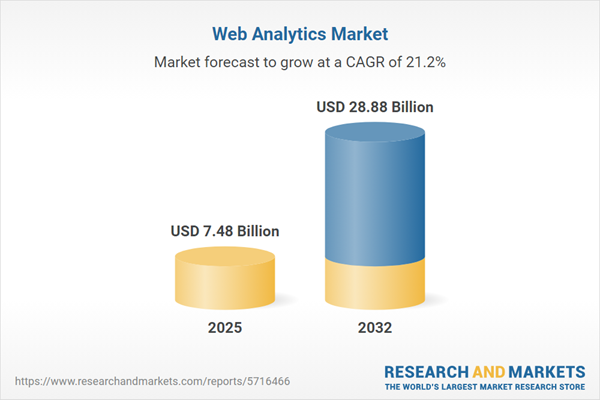Speak directly to the analyst to clarify any post sales queries you may have.
The web analytics market is transforming how organizations leverage digital data, drive operational efficiency, and meet compliance requirements in a rapidly evolving business landscape.
Market Snapshot: Growth and Opportunity in the Web Analytics Market
In 2024, the web analytics market is valued at USD 6.19 billion, with projections to reach USD 7.48 billion in 2025 and expand further to USD 28.88 billion by 2032. This highly dynamic market is underpinned by a 21.22% CAGR, reflecting accelerated enterprise adoption of digital intelligence, increased complexity in organizational data environments, and heightened compliance demands. Digital transparency and competitiveness are top priorities for organizations, prompting a shift toward integrated analytics platforms. For senior leaders, this environment presents opportunities to enhance operational resilience and maximize value through efficient use of analytics tools and data-driven decision-making.
Scope & Segmentation: Comprehensive Market Coverage for Analytics Strategy
This report provides structured market insights tailored for executive decision-makers, aiding in the optimization of analytics strategies and informed procurement:
- Product Types: Covers hardware such as servers, networking devices, and storage, as well as consulting, systems integration, and technical support services. Examines how advanced analytics software is integral to achieving strategic transformation and shifting organizational workflows.
- Applications: Investigates analytics adoption in core sectors, including finance, insurance, healthcare, manufacturing, and retail. Assesses how sector-specific standards, compliance requirements, and operational challenges shape technology selection and project outcomes.
- Deployment Modes: Analyzes the suitability of cloud-based and on-premises solutions based on differing data governance standards, risk appetites, scalability needs, and compliance frameworks across regions and industries.
- Company Size: Explores analytics adoption across organizations from large enterprises to smaller companies, focusing on IT readiness, scalability expectations, and investment perspectives that steer technology decisions at various stages of growth.
- Regional Scope: Tracks market activity and infrastructure maturity across Americas, Europe, Middle East & Africa, and Asia-Pacific. Considers how local regulations, competitive conditions, and infrastructure levels influence adoption rates and supplier strategies.
- Leading Suppliers: Profiles key vendors—Google LLC, Adobe Inc., Oracle Corporation, IBM Corporation, SAS Institute Inc.—and assesses vendor strengths, partner models, and capabilities in facilitating analytics adoption for a diverse client base.
Key Takeaways for Senior Decision-Makers
- Embedding artificial intelligence and machine learning within analytics platforms enables organizations to generate tailored insights and take proactive measures in volatile market conditions.
- Advanced analytics platforms now address increased security and privacy demands, supporting organizations in maintaining compliance across various legal jurisdictions and industry standards.
- Cloud-based analytics provide flexibility and streamlined operations, while on-premises infrastructure supports organizations needing higher control due to regulatory or internal requirements.
- Industry-focused analytics are enabling financial institutions to strengthen data governance, healthcare organizations to optimize patient care delivery, and retailers to enhance customer engagement.
- Procurement teams are prioritizing seamless integration, strategic adaptability, and clear metrics for assessing return on analytics investments as part of long-term value realization.
Tariff Impact: Navigating Procurement Amid Regulatory Changes
Recent changes to regulatory and tariff structures in the United States are impacting procurement strategies for analytics platforms and supporting technologies. Decision-makers are modifying supplier contracts, adopting modular service models, and adjusting licensing terms to balance cost management with operational stability. These measures empower organizations to remain compliant and agile as regulatory environments evolve.
Methodology & Data Sources
This research draws from executive interviews, extensive secondary source evaluations, and advanced quantitative modeling with regression-based analytics and data validation. The methodology ensures actionable, reliable recommendations for leaders evaluating opportunities and risks within the web analytics market.
Why This Report Matters for Senior Leaders
- Provides focused web analytics market intelligence and actionable recommendations for senior leadership navigating changing data and compliance landscapes.
- Offers detailed segmentation and practical analysis to enhance procurement choices and strategic planning in competitive and regulated environments.
- Enables benchmarking of leading vendors and supports informed investment and capital allocation for analytics-driven outcomes aligned with business priorities.
Conclusion
This report enables organizations to advance analytics-centered strategies, mitigate operational risks, and drive digital transformation confidently in a rapidly changing marketplace.
Additional Product Information:
- Purchase of this report includes 1 year online access with quarterly updates.
- This report can be updated on request. Please contact our Customer Experience team using the Ask a Question widget on our website.
Table of Contents
3. Executive Summary
4. Market Overview
7. Cumulative Impact of Artificial Intelligence 2025
Companies Mentioned
The companies profiled in this Web Analytics market report include:- Google LLC
- Adobe Inc.
- Oracle Corporation
- IBM Corporation
- SAS Institute Inc.
- InnoCraft Ltd.
- Mixpanel Inc.
- Amplitude Inc.
- Heap, Inc.
- AT Internet SAS
Table Information
| Report Attribute | Details |
|---|---|
| No. of Pages | 199 |
| Published | October 2025 |
| Forecast Period | 2025 - 2032 |
| Estimated Market Value ( USD | $ 7.48 Billion |
| Forecasted Market Value ( USD | $ 28.88 Billion |
| Compound Annual Growth Rate | 21.2% |
| Regions Covered | Global |
| No. of Companies Mentioned | 11 |









